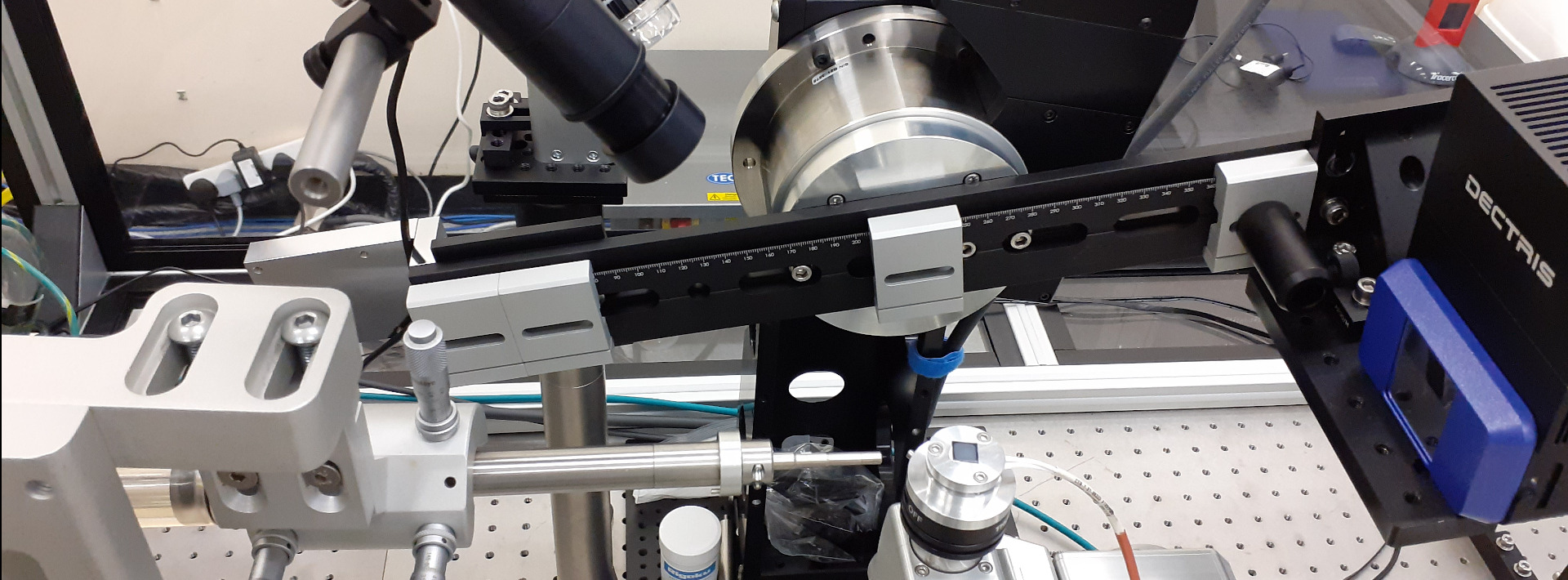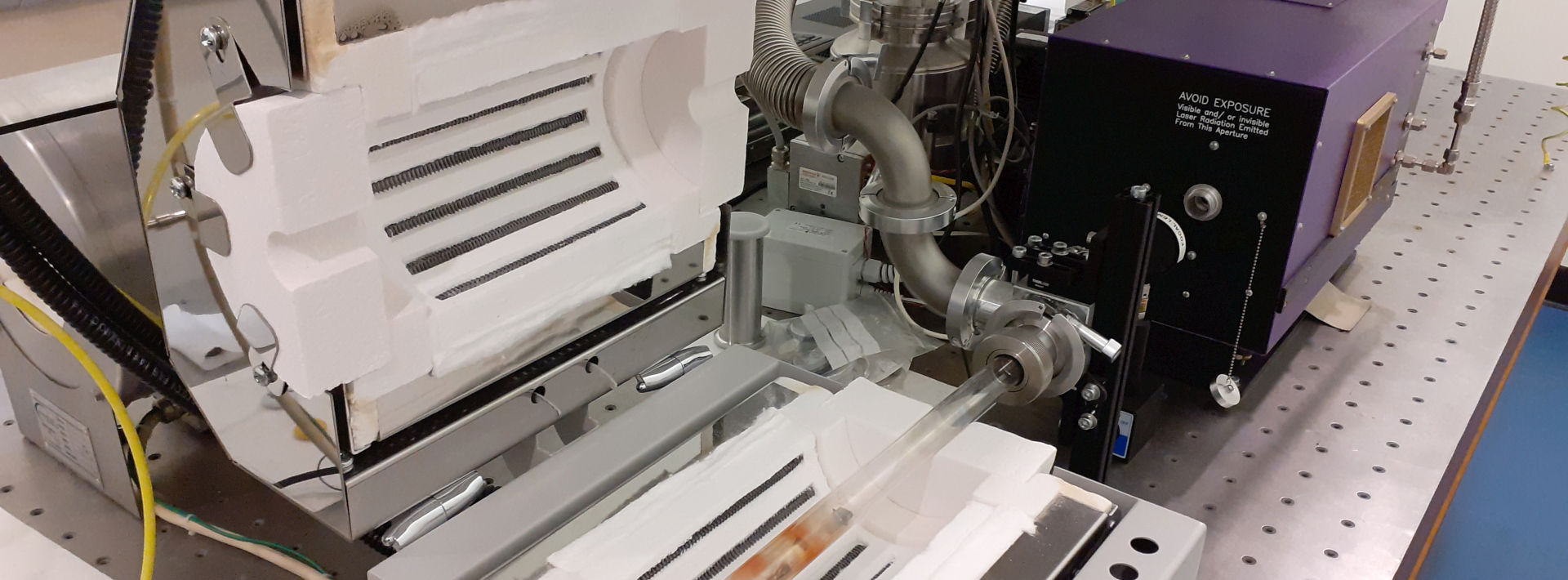|
|
| (29 intermediate revisions by the same user not shown) |
| Line 2: |
Line 2: |
| | | | |
| | __NOTOC__ | | __NOTOC__ |
| | + | __INDEX__ |
| | | | |
| | + | <metadesc>Coherent X-ray Science Group facilities furnished by research grants awarded to Marcus Newton. </metadesc> |
| | == Facilities: == | | == Facilities: == |
| | | | |
| − | === CXS Laboratory ===
| |
| | | | |
| − | [[Image:laserlab.png|thumb|350px|none|alt= <!-- --> | CXS Laboratory ]]
| + | === X-ray Diffraction Imaging Laboratory === |
| | | | |
| − | The CXS laboratory is primarily used for the synthesis of nanometre scale crystals and device structures. Pulsed laser deposition (PLD) permits the synthesis of complex transition metal-oxide materials such as vanadates, cuprates and manganites as thin films or as heterostructures. Our laboratory houses a 248 nm KrF and a 193 nm ArF excimer laser, both of which are routinely used for pulsed laser deposition and laser-assisted fabrication. The CXS laboratory is also equip with a thermal vacuum tube furnace and various gases for nanoscale crystal synthesis via thermal CVD. The synthesis equipment is supported by an optical table and accompanying overhead rack for electrical equipment.
| + | <div class="res-img"> |
| | + | [[File:xrdi.jpg|center]] |
| | + | </div> |
| | | | |
| | + | The X-ray Diffraction Imaging (XRDI) system consists of a Rigaku MicroMax-007 rotating anode x-ray generator that generates x-rays with a wavelength of 1.54 Å (Cu anode) and focuses x-rays down to a diameter of 0.075 mm. X-ray are imaged with a Dectris Eiger2 area detector that is capable of single photon counting and can operate at high frequency. This setup is ideally suited for nanoscale crystal structure determination and streamlined sample preparation for advanced lens-less X-ray imaging techniques such as [[Research#Coherent Diffraction Imaging | Bragg Coherent X-ray Diffraction Imaging]] (BCXDI) as performed at synchrotron facilities such as the Diamond Light Source. |
| | | | |
| − | === Nanofabrication Centre === | + | === Sample Preparation Room === |
| | | | |
| − | [[Image:nanofab.png|thumb|350px|none|alt= <!-- --> | Southampton Nanofabrication Centre ]] | + | <div class="res-img"> |
| | + | [[File:cleanroom.jpg|center]] |
| | + | </div> |
| | | | |
| − | The [http://www.southampton-nanofab.com Southampton Nanofabrication Centre] is a state-of-the-art facility for microfabrication and high-spec nanofabrication, as well as a wide range of characterisation capabilities housed in the new Mountbatten Complex at the University of Southampton. One of the premiere cleanrooms in Europe, the Centre has a uniquely broad range of technologies, combining traditional and novel top down fabrication with state-of-the-art bottom up fabrication. This allows us to develop and produce a wide range of devices in diverse fields such as electronics, nanotechnology and bionanotechnology and incorporate them into an equally comprehensive array of nano and microsystems for analysis and use. The characterisation capability is similarly extensive catalogue of microscopes and test gear, from nanometre resolution scanning microscopes to electrical, magnetic and RF analysis. | + | The sample preparation room is equip with a fume cupboard that houses a spin coater, sonic bath, hot plate and weighing scale. There is also an optical microscope with micromanipulator for sample inspection and manipulation. |
| | | | |
| − | === Iridis === | + | === Synthesis Laboratory === |
| | | | |
| − | [http://cmg.soton.ac.uk/iridis Iridis] is the University of Southampton's major high performance computing facility. It boasts 250 TeraFlops of computer performance. Currently in it's fourth generation, Iridis is the most powerful university-based supercomputer in England and the third largest academic supercomputing facility in the UK. Iridis is ranked in the top ten of the UK’s elite supercomputers. The facility is powered by IBM® Intelligent Cluster solutions and includes Intel® Xeon Phi™ coprocessors, which can take control of some of the most demanding mathematical calculations to significantly increase its processing power. The Intel® Xeon Phi™ coprocessors are each capable of running at one teraflop, (one trillion calculations per second). | + | <div class="res-img"> |
| | + | [[File:laserlab.jpg|center]] |
| | + | </div> |
| | | | |
| | | | |
| − | === Diamond Light Source ===
| + | The CXS Synthesis laboratory is primarily used for the synthesis of nanometre scale crystals and device structures. Pulsed laser deposition (PLD) permits the synthesis of complex transition metal-oxide materials such as vanadates, cuprates and manganites as thin films or as heterostructures. Our laboratory houses a 248 nm KrF excimer laser for pulsed laser deposition and laser-assisted fabrication. The laboratory is also equip with two thermal vacuum tube furnaces and various gases for nanoscale crystal synthesis via thermal CVD. |
| | | | |
| − | [[Image:diamond.png|thumb|350px|none|alt= <!-- --> | Diamond Light Source ]]
| + | <br clear=all> |
| − | The [http://www.diamond.ac.uk Diamond Light Source] is the UK’s national synchrotron science facility, located at the Harwell Science and Innovation Campus in Oxfordshire. The facility is used by over 3,000 academic and industrial researchers across a wide range of disciplines including structural biology, energy, engineering, nanoscience and environmental sciences.
| |
| − | We utilise this facility for Coherent X-ray Diffraction Imaging experiments.
| |
| − | | |
| − | | |
| − | === SACLA === | |
| − | | |
| − | [[Image:sacla.png|thumb|350px|none|alt= <!-- --> | SACLA ]]
| |
| − | To gain a full understanding of physical and biological phenomena, we need to look at the way atoms and molecules are structured and function, and how the electrons within them move. Being able to directly observe the arrangement and movements of these atoms and electrons would enable us to develop drugs for hard-to-cure diseases and to study ultra-fast structural processes. The [http://xfel.riken.jp/eng/ SPring-8 Angstrom Compact Free Electron Laser] (SACLA) is the most compact X-ray Free Electron Laser (XFEL) facility in the world, and is also now the only XFEL operating below 1 Å wavelength. SACLA was built jointly by RIKEN and JASRI as one of the Key Technologies of National Importance, and was completed in March 2011. SACLA's benefits include short wavelength and femto-second pulse-width, enabling the observation of living organisms and materials at the atomic level.
| |
Facilities:
X-ray Diffraction Imaging Laboratory
The X-ray Diffraction Imaging (XRDI) system consists of a Rigaku MicroMax-007 rotating anode x-ray generator that generates x-rays with a wavelength of 1.54 Å (Cu anode) and focuses x-rays down to a diameter of 0.075 mm. X-ray are imaged with a Dectris Eiger2 area detector that is capable of single photon counting and can operate at high frequency. This setup is ideally suited for nanoscale crystal structure determination and streamlined sample preparation for advanced lens-less X-ray imaging techniques such as Bragg Coherent X-ray Diffraction Imaging (BCXDI) as performed at synchrotron facilities such as the Diamond Light Source.
Sample Preparation Room
The sample preparation room is equip with a fume cupboard that houses a spin coater, sonic bath, hot plate and weighing scale. There is also an optical microscope with micromanipulator for sample inspection and manipulation.
Synthesis Laboratory
The CXS Synthesis laboratory is primarily used for the synthesis of nanometre scale crystals and device structures. Pulsed laser deposition (PLD) permits the synthesis of complex transition metal-oxide materials such as vanadates, cuprates and manganites as thin films or as heterostructures. Our laboratory houses a 248 nm KrF excimer laser for pulsed laser deposition and laser-assisted fabrication. The laboratory is also equip with two thermal vacuum tube furnaces and various gases for nanoscale crystal synthesis via thermal CVD.


